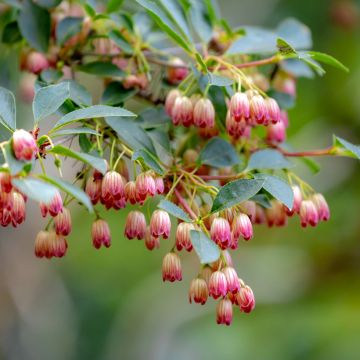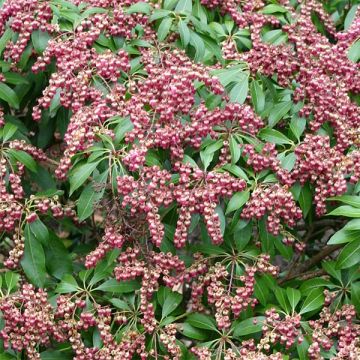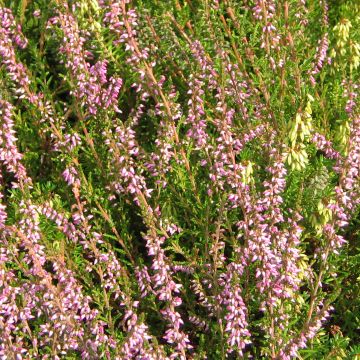

Pieris formosa var. forrestii - Himalayan Andromeda
Pieris formosa var. forrestii - Himalayan Andromeda
Pieris formosa var. forrestii
Taiwan pieris, Himalayan andromeda
Special offer!
Receive a €20 voucher for any order over €90 (excluding delivery costs, credit notes, and plastic-free options)!
1- Add your favorite plants to your cart.
2- Once you have reached €90, confirm your order (you can even choose the delivery date!).
3- As soon as your order is shipped, you will receive an email containing your voucher code, valid for 3 months (90 days).
Your voucher is unique and can only be used once, for any order with a minimum value of €20, excluding delivery costs.
Can be combined with other current offers, non-divisible and non-refundable.
Home or relay delivery (depending on size and destination)
Schedule delivery date,
and select date in basket
This plant carries a 24 months recovery warranty
More information
We guarantee the quality of our plants for a full growing cycle, and will replace at our expense any plant that fails to recover under normal climatic and planting conditions.
Would this plant suit my garden?
Set up your Plantfit profile →
Description
The Formosa Andromeda (Pieris formosa) is a magnificent evergreen acidophilous bush for "jungle" or exotic style gardens. It is appreciated for its bright red young leaves in spring and its beautiful clusters of trailing white flowers. This species, much less common than the Japanese Andromeda, thrives in semi-shaded areas of the garden, in humus-bearing and moist soil, with large Rhododendrons, for example.
The Pieris belong to the heather family, just like heathers and rhododendrons. They are humus-bearing bush species, or at least prefer non-calcareous soils, rich in organic matter (humus), not too dry but not waterlogged.
The Pieris formosa is a botanical species native to the mountains of Asia, particularly from Yunnan in China and the Himalayas. This slow-growing bush reaches a height of 3 to 4 meters with a width of approximately 1.8 meters at maturity. It bears evergreen, decorative foliage even in winter. In spring, its young shoots emerge in a coppery red hue before turning dark green. The leaves are long, measuring between 8 and 18 cm, with finely toothed edges. In April, the bush produces numerous small bell-shaped white flowers, clustered in long trailing panicles, which beautifully contrast with the foliage. This bush is hardy down to -15°C once mature, but it needs protection from strong winds. Its growth can be damaged from -11°C, especially in young specimens. However, it is much less cold-resistant than its close relative, Pieris japonica.
The Formosa Andromeda is a beautiful plant for large "heather soil" beds or flowering hedges in slightly sheltered gardens. For creating beautiful contrasts, it can be paired with plants like Rhododendron loderi 'King George', Chinese Azalea, Arborescent Hydrangea 'Hills of Snow' or even Autumn Camellias, which share similar soil and exposure requirements.
Report an error about the product description
Plant habit
Flowering
Foliage
Botanical data
Pieris
formosa var. forrestii
Ericaceae
Taiwan pieris, Himalayan andromeda
Pieris formosa, Pieris forrestii, Andromeda formosa
China
Other Pieris
View all →Planting and care
To cultivate the Formosa Andromeda (Pieris formosa var. forrestii), choose a semi-shaded to sunny location, well protected from strong winds that can damage its foliage and sensitive young shoots. This plant requires an acidophilous soil (pH between 4.5 and 6), well-drained and rich in organic matter. Use heather soil enriched with fertiliser, a mix of sand and compost, or a clay-sandy soil to ensure good root aeration. The soil should be kept moist, without excess water to prevent root rot. An organic mulch made of compost or dead leaves is ideal for maintaining moisture in summer and enriching the soil with organic matter.
When planting, dig a hole twice as wide as the root ball and mix compost or turf into the soil to improve soil structure. Watering should be regular, especially during the first months after planting and in dry periods. Light fertilisation, with a specific fertiliser for acidophilous plants in spring, will promote healthy growth and beautiful flowering. Light pruning after flowering can help maintain a compact and elegant habit.
Planting period
Intended location
Care
This item has not been reviewed yet - be the first to leave a review about it.
Similar products
Haven't found what you were looking for?
Hardiness is the lowest winter temperature a plant can endure without suffering serious damage or even dying. However, hardiness is affected by location (a sheltered area, such as a patio), protection (winter cover) and soil type (hardiness is improved by well-drained soil).

Photo Sharing Terms & Conditions
In order to encourage gardeners to interact and share their experiences, Promesse de fleurs offers various media enabling content to be uploaded onto its Site - in particular via the ‘Photo sharing’ module.
The User agrees to refrain from:
- Posting any content that is illegal, prejudicial, insulting, racist, inciteful to hatred, revisionist, contrary to public decency, that infringes on privacy or on the privacy rights of third parties, in particular the publicity rights of persons and goods, intellectual property rights, or the right to privacy.
- Submitting content on behalf of a third party;
- Impersonate the identity of a third party and/or publish any personal information about a third party;
In general, the User undertakes to refrain from any unethical behaviour.
All Content (in particular text, comments, files, images, photos, videos, creative works, etc.), which may be subject to property or intellectual property rights, image or other private rights, shall remain the property of the User, subject to the limited rights granted by the terms of the licence granted by Promesse de fleurs as stated below. Users are at liberty to publish or not to publish such Content on the Site, notably via the ‘Photo Sharing’ facility, and accept that this Content shall be made public and freely accessible, notably on the Internet.
Users further acknowledge, undertake to have ,and guarantee that they hold all necessary rights and permissions to publish such material on the Site, in particular with regard to the legislation in force pertaining to any privacy, property, intellectual property, image, or contractual rights, or rights of any other nature. By publishing such Content on the Site, Users acknowledge accepting full liability as publishers of the Content within the meaning of the law, and grant Promesse de fleurs, free of charge, an inclusive, worldwide licence for the said Content for the entire duration of its publication, including all reproduction, representation, up/downloading, displaying, performing, transmission, and storage rights.
Users also grant permission for their name to be linked to the Content and accept that this link may not always be made available.
By engaging in posting material, Users consent to their Content becoming automatically accessible on the Internet, in particular on other sites and/or blogs and/or web pages of the Promesse de fleurs site, including in particular social pages and the Promesse de fleurs catalogue.
Users may secure the removal of entrusted content free of charge by issuing a simple request via our contact form.
The flowering period indicated on our website applies to countries and regions located in USDA zone 8 (France, the United Kingdom, Ireland, the Netherlands, etc.)
It will vary according to where you live:
- In zones 9 to 10 (Italy, Spain, Greece, etc.), flowering will occur about 2 to 4 weeks earlier.
- In zones 6 to 7 (Germany, Poland, Slovenia, and lower mountainous regions), flowering will be delayed by 2 to 3 weeks.
- In zone 5 (Central Europe, Scandinavia), blooming will be delayed by 3 to 5 weeks.
In temperate climates, pruning of spring-flowering shrubs (forsythia, spireas, etc.) should be done just after flowering.
Pruning of summer-flowering shrubs (Indian Lilac, Perovskia, etc.) can be done in winter or spring.
In cold regions as well as with frost-sensitive plants, avoid pruning too early when severe frosts may still occur.
The planting period indicated on our website applies to countries and regions located in USDA zone 8 (France, United Kingdom, Ireland, Netherlands).
It will vary according to where you live:
- In Mediterranean zones (Marseille, Madrid, Milan, etc.), autumn and winter are the best planting periods.
- In continental zones (Strasbourg, Munich, Vienna, etc.), delay planting by 2 to 3 weeks in spring and bring it forward by 2 to 4 weeks in autumn.
- In mountainous regions (the Alps, Pyrenees, Carpathians, etc.), it is best to plant in late spring (May-June) or late summer (August-September).
The harvesting period indicated on our website applies to countries and regions in USDA zone 8 (France, England, Ireland, the Netherlands).
In colder areas (Scandinavia, Poland, Austria...) fruit and vegetable harvests are likely to be delayed by 3-4 weeks.
In warmer areas (Italy, Spain, Greece, etc.), harvesting will probably take place earlier, depending on weather conditions.
The sowing periods indicated on our website apply to countries and regions within USDA Zone 8 (France, UK, Ireland, Netherlands).
In colder areas (Scandinavia, Poland, Austria...), delay any outdoor sowing by 3-4 weeks, or sow under glass.
In warmer climes (Italy, Spain, Greece, etc.), bring outdoor sowing forward by a few weeks.


















































